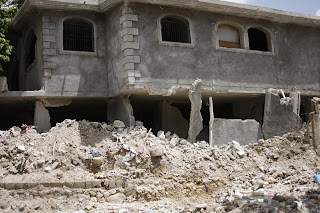
Visiting Haiti and meeting people was a heartfelt experience for me. I travelled to Haiti with my wife Debbie and our youngest daughter Natascha who is 17. From Thailand, we went to Miami, FL and then flew to Port-au-Prince and spent more than a week in Haiti.
Our trip was very successful and the sun was shining all week except a few heavy rains in the evenings. Children played on the street. Mothers washed clothes and took bath in open-air tubs along the roads. Tents and tarps put up by foreign donors are seen everywhere, along roadsides and empty lots. Haitians have set up small businesses along the narrow streets selling food, bananas, shoes, charcoal and necessities.
On the day of our arrival, we were very fortunate to meet with the members of the National Spiritual Assembly the Bahai’s of Haiti including the secretary Mr. Glenn. They provided us with their guidance and prayers. We spent several days visiting schools including Anisi Zunini school and talking to children and teachers. At the school, Natascha visited nearly ten classrooms giving talks, comforting and inspiring them. She was also interviewed by a local radio station, accompanied by one of the NSA members, Linda, who is also the director of CAFT, an NGO registered in Haiti.
We also had a special meeting with the Administrative Committee of the Anisi Zunini school and discussed their future plans. Currently the classes are held outside the building under trees and sheds.
We met several NGOs including Architecture for Humanity and government officials. We toured one of the largest tent camps where nearly 20,000 people are temporarily housed in tents and more then 40,000 squatters waiting their turn. When the rains come, the ground turns to mud and life is miserable for them. The head of the camp is Richard Poole and run by the American Refugees Committee (ARC).
Exactly six months after the earthquake hit Haiti, the capital city, Port-au-Prince, is still in disarray. Getting from one point to another takes a good part of your day - many of the roads looked like they have been bombed. There is concrete rubble and broken down vehicles stripped of their tires dotted along the roads. We were told that only 4 percent of the rubble has been removed so far, which we could believe as we saw only a few people removing it by hand.
The people of Haiti are friendly and incredibly resourceful. They are aware that the attention of the world is on Haiti like it has never been. During our meeting with the Deputy Director of the Ministry of Education, Mr. J.M. Cesar, he was genuinely touched by the presence of so many foreigners and NGOs and with our visit. We talked to him and his junior officials about our mission.

Nearly 45 percent of the population are children and are the most disoriented and vulnerable of the survivors of the earthquake. Many tens of thousands have lost their parents and their homes. Ninety percent of the schools in Port-au-Prince are damaged or destroyed. Reconstruction has not begun yet. All classes are conducted outside the damaged buildings under temporary shelters or trees.


During our trip, we explored several possibilities for helping the children of Haiti. Our mission was to assist in their education. We looked into several options to rebuild educational institutions with the guidance of the Baha’i community. We had meetings with school authorities and non-governmental agencies to build a structure to support education for children. We have identified a few options including repairing a school, providing it with a teacher training center and support in their development of a visual arts curriculum for the school.
During the next few months, we will continue to work with our friends in Haiti to finalize our construction plans. A need has been identified to start a teacher training institute as we feel that the training of teachers in effective moral education in addition to academic excellence is critical in the transformation of society and the success of the community.
As they move from relief aid stage to long-term reconstruction, the government, in partnership with foreign governments and NGOs, are making plans to rebuild the city. This will take years. Foreign governments have pledged nearly 11.4 billion dollars, but the people have not seen the money yet - at least we did not see any progress in cleaning up the city or visible signs of reconstruction.
We hope that all parties concerned will work hard to develop some sound economic policies that address extreme poverty and deep-rooted disparities of wealth, making sure every child receives an education, and to treat everyone as members of one family.






Comments